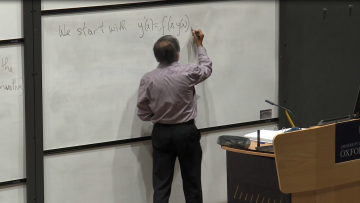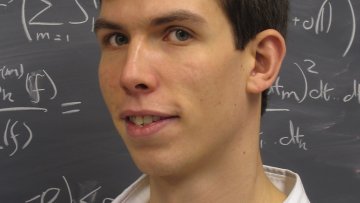We continue with our series of Student Lectures with this first lecture in the 2nd year Course on Differential Equations. Professor Philip Maini begins with a recap of the previous year's work before moving on to give examples of ordinary differential equations which exhibit either unique, non-unique, or no solutions. This leads us to Picard's Existence and Uniqueness Theorem...
Symplectic geometry of Conical Symplectic Resolutions
Abstract
Conical Symplectic Resolutions form a broad family of holomorphic symplectic manifolds that are of interest to mathematical physicists, algebraic geometers, and representation theorists; Nakajima Quiver Varieties and Hypertoric Varieties are known as their special cases. In this talk, I will be focused on the Symplectic Geometry of Conical Symplectic Resolutions, and its non-symplectic applications. More precisely, I will talk about my work on finding Exact Lagrangian Submanifolds inside CSRs, and work in progress (joint with Alexander Ritter) about the construction of Symplectic Cohomology on CSRs.
Oxford Mathematician James Maynard has been awarded the 2020 Cole Prize in Number Theory by the American Mathematical Society (AMS) "for his many contributions to prime number theory."
A parabolic toy-model for the Navier-Stokes equations
Abstract
In the seminar, I will talk about a parabolic toy-model for the incompressible Navier-Stokes equations, that satisfies the same energy inequality, same scaling symmetry and which is also super-critical in dimension 3. I will present some partial regularity results that this model shares with the incompressible model and other results that occur only for our model.
Formation of singularities for the relativistic Euler equations/Global Well-Posedness for a Class of Stochastic McKean-Vlasov Equations in One Dimension
Abstract
Formation of singularities for the relativistic Euler equations (N. Athanasiou): An archetypal phenomenon in the study of hyperbolic systems of conservation laws is the development of singularities (in particular shocks) in finite time, no matter how smooth or small the initial data are. A series of works by Lax, John et al confirmed that for some important systems, when the initial data is a smooth small perturbation of a constant state, singularity formation in finite time is equivalent to the existence of compression in the initial data. Our talk will address the question of whether this dichotomy persists for large data problems, at least for the system of the Relativistic Euler equations in (1+1) dimensions. We shall also give some interesting studies in (3+1) dimensions. This is joint work with Dr. Shengguo Zhu.
Global Well-Posedness for a Class of Stochastic McKean-Vlasov Equations in One Dimension (A. Mayorcas): We show global well-posedness for a family of parabolic McKean--Vlasov SPDEs with additive space-time white noise. The family of interactions we consider are those given by convolution with kernels that are at least integrable. We show that global well-posedness holds in both the repulsive/defocussing and attractive/focussing cases. Our strategy relies on both pathwise and probabilistic techniques which leverage the Gaussian structure of the noise and well known properties of the deterministic PDEs.
Numerical simulations of immersed granular collapses with dense and loose initial packings
Abstract
The collapse of granular columns in a viscous fluid is a common model case for submarine geophysical flows. In immersed granular collapses, dense packings result in slow dynamics and short runout distances, while loose packings are associated with fast dynamics and long runout distances. However, the underlying mechanisms of the triggering and runout, particularly regarding the complex fluid-particle interactions at the pore-scale, are yet to be fully understood. In this study, a three-dimensional approach coupling the Lattice Boltzmann Method and the Discrete Element Method is adopted to investigate the influence of packing density on the collapsing dynamics. The direct numerical simulation of fluid-particle interactions provides evidence of the pore pressure feedback mechanism. In dense cases, a strong arborescent contact force network can form to prevent particles from sliding, resulting in a creeping failure behavior. In contrast, the granular phase is liquefied substantially in loose cases, leading to a rapid and catastrophic failure. Furthermore, hydroplaning can take place in loose cases due to the fast-moving surge front, which reduces the frictional resistance dramatically and thereby results in a longer runout distance. More quantitatively, we are able to linearly correlate the normalized runout distance and the densimetric Froude number across a wide range of length scales, including small-scale numerical/experimental data and large-scale field data.
From red to white: The time-varying nature of oceanic heat flux in the Arctic
Abstract
Arctic sea ice is one of the most sensitive components of the Earth’s climate system. The underlying ocean plays an important role in the evolution of the ice cover through its heat flux at the ice-ocean interface. Despite its importance, the spatio-temporal variations of this heat flux are not well understood. In this talk, I will take the following approach to study the variations in the heat flux. First, I will consider the problem of classical Rayleigh-Bénard convection and systematically explore the effects of fractal boundaries on heat transport using direct numerical simulations. And second, I will analyze time-series data from the Surface Heat Budget of the Arctic Ocean (SHEBA) program using Multifractal Detrended Fluctuation Analysis (MFDFA) to understand the nature of fluctuations in the heat flux. I will also discuss developing simple stochastic ODEs using results from these studies.



